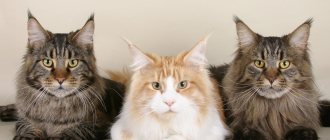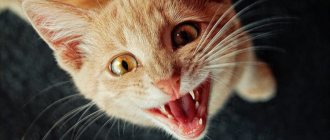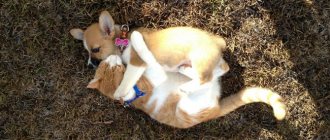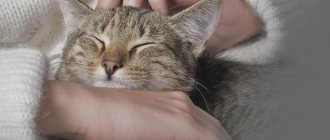Learning about the world from fairy tales and cartoons, we have learned that cats and dogs are at enmity, the wolf and the fox are friends, the mouse knows how to appear at the right moment, and “fools” are always lucky. Of course, fairy tales have morals, meaning, and some experience, but some of the clichés in them are wrong. The feud between cats and dogs is one of the made-up facts. Note that in almost all fairy tales, cats are very cunning and even two-faced, while dogs are simple-minded and naive. Let's get to the bottom of why cats and dogs often don't get along and what's stopping them.
Frontiers on lock
Dogs and cats have completely opposite ideas and outlooks on life. The dog is a collective animal, in nature it lives in packs, and its fellow tribesmen are of great importance to it. A cat, on the contrary, “walks on its own” values solitude, catches prey on its own, eats it itself, and does not share it with anyone. But these animals have one thing in common: both animals are territorial, accustomed to guarding their borders and protecting them from outsiders.
Dogs and cats are predatory animals; protecting their territory is very important for them, just as it is for a hunter to protect their territory. One of the reasons why dogs hate cats is because they claim territory. It is easier for packs to win a place in the sun, so dogs took the lead. Weight and size are secondary causes. The ancestors of domestic cats were not inferior in size to dogs, but failed because they preferred loneliness.
Dogs chase cats because a pack is quite effective against one enemy, but today's domestic cat has not lost its courage. And if it had been the other way around, a pack of cats for one dog, it remains to be seen who would have won.
There is another version: competition at the genetic level. It is possible that the ancestors of domestic cats were saber-toothed tigers, which at one time greatly offended the canine family, and this is the basis for dogs’ rejection of cats. The desire to take revenge on the descendants of one’s enemies occurs at the genetic level.
Hunting instinct
The zeal of dogs for cats can also be explained by the hunting instincts inherent in many breeds. For such dogs, many animals are regarded as potential prey, regardless of whether the cat is a raccoon or a fox, therefore, in dogs, the hunting instinct is triggered, and in cats, the instinct of self-preservation begins and the chase and hostility begin.
© shutterstock
Companion and loner
Zoologists, figuring out the reasons for animal hostility, came to the logical conclusion that it is not the dog that is afraid of the cat, it simply does not want to make contact. Murkas really don’t like violations of their space; they feel great alone; dogs, on the contrary, have a thirst for communication. Ordinary curiosity can push a good-natured dog to approach an unfamiliar cat, but the acquaintance will not end well; the dog will either run away or scratch the dog.
This is another reason for enmity; a running away cat can awaken the hunter’s instinct in a peace-loving animal; if, sitting still, it hisses and tries to scratch, then the dog’s defensive reaction will lead to aggression, and the puppy to fright. One negative experiment is enough, which will be remembered by the associative memory of animals, to wage an irreconcilable war for the rest of their lives.
When driving a cat up a tree, many dogs do not experience any aggression; they perceive it as a fun game; a cat sitting on a tree interprets the situation completely differently.
Fight for territory
The domestic cat has a pronounced territorial instinct, illustrating the saying that whiskered tabby cats are more attached to a place than to their owner. Thus, Murka clearly considers an apartment, a private house, and even the entire owner’s yard to be his property.
In the wild, canines and cats living in the same territory are competitive predators, which means they are forced to divide hunting grounds and defend their boundaries:
- Yard cats. The territory of a street cat “walking on its own” is very vast, and not only fellow cats, but also dogs fall into the category of uninvited guests. That is why the cat, comfortably dozing on a bench at “his” entrance, will arch and hiss when he sees the approaching dog.
- Dogs. Dogs, in turn, also diligently mark the territory with urine marks and bark at the aliens. In R. Kipling’s fairy tale, the Dog’s appeal to the Cat sounds like a sign and an oath of eternal hatred: “Walk, walk, but not where I am. Otherwise I’ll bark, run at you and drive you up a tree. And so will all dogs do, from now on and forever and ever.”
Misunderstanding each other
You might think that since animals cannot agree with each other, it means that one of them is not very smart. A cat and a dog are like the French and the Chinese, knowing only their own languages. People can agree with each other using gestures that have common meanings, but with pets this is much more difficult.
By wagging its tail, a dog shows its disposition towards something; in a cat it means anxiety, concern, aggression. When a dog sits down, slightly wags its tail, presses its ears down on its lowered head, and visually strives to shrink, it means that it is guilty and completely submits. The cat presses its ears and bends down before attacking. Cats fall on their backs and put their clawed paws forward when they should actively defend themselves, while dogs with this pose show you complete trust and submission. With such differences in behavior, it is quite difficult for them to understand each other.
Now we know why dogs are against cats
It would seem that this is an eternal struggle between dogs and cats. And it is completely unclear why dogs are against cats. But in fact, the answer turns out to be quite simple if you look at the root of the problem and understand the language of animals. , as well as the motivation for their actions. Let's find out another secret about the dog?
Dogs and cats have little in common, but there is one thing in common that separates them - they are both predators. Each predator must have its own territory in which it could hunt. Of course, our pets are now domesticated, but the ancient instincts still ferment and languish in their bodies.
Lonely fighter
Any incompetent person, asking him what is the reason for the enmity between animals, will answer without hesitation, cats are afraid of dogs. They are big, strong, with sharp fangs, and the cats are so cute, fluffy, of course they are scared.
Having observed the habits of an ordinary yard cat during a chance meeting with a strange dog, it becomes clear that this is far from the case. Murka is not at all afraid of the dog, he just looks attentively at the stranger, bends over and waits for his reaction. She has enough time to run away, but she has no fear; instead, Murka assesses the situation. This is another reason why there is eternal enmity between dogs and cats. The cat does not feel fear, and if necessary, it will prove the proverb: “there is no beast worse than a cat.”
Some cats neglect dogs so much, strolling serenely in front of them, wagging their tail, as if they were deliberately teasing them. This picture makes it clear why dogs chase cats. The cunning animal deliberately provokes the dog, and at the first danger it climbs a tree. The dog jumps furiously in front of the tree, and the fearless cat sits and carefully watches him, while she doesn’t look scared at all. As soon as the dog gets tired of the useless activity and begins to move away, the cat goes downstairs, the scene is repeated again and again. By deliberately egging on the dog, the cat forces him to chase the robber to no avail.
Scientists from England conducted a series of studies and came to the conclusion that cats have a special enzyme that is unacceptable for dogs. This enzyme causes excitement and aggression, but there are many examples of true friendship between cats and dogs, which means that dogs have the ability to calmly perceive a negative enzyme.
Differences in Signal Understanding
A well-trained dog perfectly understands the owner’s commands , but not always the cat’s movements and habits. Identical movements of the tail or paws of dogs and cats are interpreted differently:
- Swinging the tail from side to side. For a dog, such a gesture is playful and friendly; cats regard it as aggression or a warning of danger.
- Pulling into an arched position. Thus, the cat begins to prepare for an attack, but the dog does not understand this. As a result, he gets a paw on the nose or fully feels the force of the cat's claws.
- A raised paw for a cat is an alarming signal indicating a possible attack. For a dog, this is simply a friendly gesture that provides for further pleasant relationships.
- Purr. This is how a cat expresses pleasure and joy, while a dog, on the contrary, prepares to attack.
If you can, catch it
Many people think that a cat is faster than a dog, but this is not true. A dog can reach speeds of up to 60 km/h, while a domestic cat is only 40 km/h. But a cat has many undeniable advantages: maneuverability, at maximum speed it perfectly runs around all obstacles, while a dog at high speed does not notice objects and can crash into a tree or pole.
The dog runs only on the ground, while the cat easily jumps on obstacles in the form of a car, tree, fence, so chasing it does not bring results. The dog has almost caught up with her, and suddenly the cat, making one jump, finds herself out of reach.
Of course, when animals meet in an open area, the cat cannot escape. The cat is not designed to run long distances, it is an excellent hunter, it watches over the prey, then, having precisely calculated the jerk, pounces on the mouse, but the prey cannot escape from its sharp claws.
A dog can pursue game for a long time and stubbornly, running many kilometers at high speed, driving the victim to the point of exhaustion.
Dogs don’t eat cats and don’t see them as food, but if an embittered dog catches up with a cat, he can give her a great beating and even cause irreparable harm to his health, but the dog won’t be in any good shape either and may well get hit by the claws of a brave cat, who knows whether he’ll be happy dog to his triumph. If the cat behaves indifferently and does not deliberately provoke the dog, then the dog will not chase it.
Fear or avoidance
To say that an adult cat is afraid of a dog would not be entirely correct.
Despite the fact that the dog is larger and stronger, the cat has in its arsenal an equally formidable weapon that can cause significant damage.
A cat can always hide in a shelter that a large dog cannot fit into, or jump to a height that is insurmountable for him. And a cat driven into a corner is the most terrible animal, as the popular saying goes.
And in fact, such an animal looks terrifying - the cat turns sideways to the enemy, bristles the fur all over its body, arches its back and hisses threateningly. Even the biggest dogs freeze at the sight of such a monster! You can often observe how a cat, which is confident in its safety, seems to provoke the dog into aggressive actions. So, it is impossible to say unequivocally that a small fluffy, affectionate cat is mortally afraid of an angry huge dog - it all depends on the situation. And the cat tries to prevent a situation where the dog seriously wants to tear her apart.
Peace instead of war
You can put forward the argument of animal enmity, saying that they are not used to being together. Usually people can be divided into cat lovers and dog supporters, but those who have two different pets at once cannot understand why they are considered enemies? Animals get used to it and get along well with each other, but only those that are kept in the same territory. It seems simply idyll when two such different pets are friends, ride together and even sleep, but this friendship is not harmless, especially when the pets find themselves outside the home. In the city, owners do not lose sight of their pets, but in a country house it is difficult to keep track.
Such friendship can only benefit a dog; a dog, accustomed to the company of a cat, will not chase other furry animals, thereby protecting its owners and itself from the wrath of cat owners. But finding itself alone, alone in a foreign territory, a domestic cat, accustomed to completely trusting the dog, treating it as a friend, will not see danger in a strange dog. She will not feel instinctive fear, she will not run away and hide, and she will definitely end up a victim of someone else’s evil dog.
You need to think carefully before keeping both a cat and a dog in the same house, because neither the owners nor the dog’s friend can always be near the furry mischief maker to save her from trouble. You should not risk your pet for the feeling of tenderness that arises when you see your cute friends. The safety of the animals and the peace of mind of the owners is much more important than fun.
There are compromises: you can have a kitten in the house in winter, and a puppy in the yard when warm days come. In this case, they will not be able to become very attached to each other, and the murka will have a guarantee of safety.
Do you love animals and don’t know which one to choose? Then you should get a cat first, so that by the time she goes outside she can grow up a little and learn how to behave around dogs. Then you can buy a puppy, the baby will not yet experience hostile feelings towards the cat, and most likely they will be able to become friends.
How to train a dog to get along with a cat at home
An equally serious problem is when a dog, living in the same area as a cat, in a house or apartment, does not allow the animal to exist in peace. If a dog reacts inappropriately to a cat, the animal’s nervous system suffers. Fluffy is forced to constantly sit on elevated surfaces and move around the house furtively.
It is best if the animals were taken at the same time, and they get used to each other from a young age. But if you get a cat after a dog, under no circumstances allow conflicts between animals or the development of hatred. If a cat is chasing a puppy or dog, spray it with a water pistol or spray bottle. Cats are afraid of water.
Scare the fluffy with a sharp sound. Do not allow the cat to eat or drink from the dog's bowls, or sleep in the house or on the dog bed. The brazen behavior of a cat will sooner or later provoke a conflict.
If a dog appeared in the house first, and then a kitten, accustom the animals to each other gradually.
- At first, do not leave them uncontrolled.
- Separate animals into different rooms.
- Stop any aggression and do not allow the dog to display its hunting instinct. Punish your dog for disobedience and inappropriate reaction to the cat at home and on the street.
- Do not allow your dog to lunge at your kitten or cat if the animal approaches the bowl.
- Make sure that the dog does not disturb the cat when he is on the tray.
If you don’t trust your dog, when leaving home, do not leave the animals in the same area or arrange a place on a hill for the cat so that the fluffy one feels relatively safe. Treat and give equal attention to all pets in the house so that no one feels hurt or left out.
Many factors play a role in the relationship between dogs and cats and other animals. Therefore, if you were unable to cope with this problem and the dog continues to chase cats on the street or at home, contact a dog handler for help.
Smart but different
If you ask about the mental abilities of animals, most people will say that, of course, a dog is much smarter than a cat. They perfectly follow commands, are obedient, they can even distinguish the words and mood of the owner, the pack lifestyle has affected the dogs’ communication skills, they are good companions, dogs can predict where an object is located and the speed of its movement. A hungry dog will get to food faster.
If a dog gives a voice when commanded to lie down or attacks an opponent, this does not mean that it is smarter. The cat will never obey the owner's commands; if only its desires coincide with the owner's command, it will obediently complete the task. Dogs recognize their reflection in the mirror, but may not recognize the owner if he comes in different clothes and smells unfamiliar. A cat cannot recognize itself in the mirror, but it will never confuse its owner.
Both animals are perfectly oriented in space and easily find their way home, but the cat has more possibilities. She can run not only on the ground, but also climb fences and tall trees, because, unlike dogs, she lives in three-dimensional space. Dogs are extroverts, love to show their emotions, and tend to get closer. Cats by nature are introverts, completely immersed in their own world, closed and not inclined to communicate.
The cat has proven its intelligence by surviving in extreme conditions all alone, in which a dog can survive only as part of a pack. Only after people know the thoughts of animals will it be possible to confidently say who is smarter.
Method five - make the cat unattractive to the pet
Try to create unpleasant associations in your dog with chasing a cat. Use any methods that are harmless to the animal׃
- sharp sound;
- cold water;
- dissatisfied tone;
- citrus-scented spray, etc.
Try spraying water on your pet if he chases the cat. The dog will remember the connection between chasing the “striped” and cold water. You can show with your voice that you are annoyed by your pet's bad behavior. Every time, let him know that his actions cause your dissatisfaction.
The pet must realize that when it actively reacts to the appearance of a cat on the horizon, the owner will be angry. You cannot shout at the dog, hit it or sharply pull the leash. You need to reprimand the dog in a calm tone with dissatisfied intonations. Animals perceive their owner’s moods very well.
If you cannot cope with the problem, contact a dog handler. He will help with training and give recommendations for further training of the dog.
Legends
There are a huge number of fairy tales and legends on the topic of enmity between cats and dogs. The Chinese put forward their own version: once upon a time, a girl who was drowning in a river was saved by a dog. The girl belonged to a noble family, and the joyful father thanked the dog by tying a decree to his tail, which stated that from now on any stray dog should be warmed and well fed. The dogs decided to celebrate such a joyful day and threw a big feast; the cat was entrusted with guarding the valuable paper. The next morning the paper with the decree disappeared. The cat explained that mice had stolen it and chewed it up, but the dogs did not believe the mustachioed sly man. Since then, dogs have been fighting with cats, and cats, in turn, have been chasing mice. When dogs meet fellow tribesmen, they look under each other’s tails in the hope of finding a treasured piece of paper there.
Another beautiful story tells that once upon a time there was a very poor man, no matter what he did, things didn’t work out for him, the harvest wasn’t born, the fish weren’t caught, everything was bad, one day he found a ring in the forest, after which things got worse things got better, luck began to favor the poor man. The cat, observing such changes, decided that it was all about the magic ring and accidentally spilled the beans to the rich neighbor. The rich man came to the house and took the ring.
The cat and the dog decided to help the poor owner by stealing the desired ring. On the way, the dog fell asleep, the cat alone brought the ring to the owner and slandered the dog, saying that he had told his neighbor, and she, clever, got it back. The man got angry with the dog and kicked him out into the yard, and began to feed him scraps. The cat is placed in the house and food is served to her in a bowl.
The dog could not forgive such a betrayal, since he envies the cat, he rushes at her wanting revenge.
Foraging
Competition for food and edible waste was most often one-sided. Dogs occupied a more advantageous position when they were close to people. Cats had to rely on their natural agility to avoid various troubles.
Guardian correspondent John Bradshaw once studied the behavior of wild cats in a Turkish village. One year, cats were everywhere and obtained food by begging for it from local residents and tourists. The following year, packs of dogs were already roaming the streets, and the journalist got the impression that the cats had disappeared. He thought so until he looked at the village from above and saw that the cats had simply moved onto the flat roofs. Most likely, they went down in search of food at night when the dogs were sleeping.
Official theory
There are many more interesting myths and tales among the people about the reasons for mutual dislike between animals. But these are just fairy tales. People who study the habits of pets give more plausible explanations for the cause of hostility: Different behavior.
A cat and a dog are diametrically opposed creatures. The dog is a noisy creature that loves to run, bark, and frolic. Let your dog into an unfamiliar apartment, and he will immediately rush to explore and inspect the rooms.
And a calm, unperturbed adult cat prefers to lie more, looking around. She is characterized by innate isolation and indifference. Philosophers! But this behavior is typical of cats who are wise in life - young fluffies behave differently.
Curious dogs, wanting to get to know the cats, run towards them. Outraged by the shamelessness, the cats quickly run away, trying to scare off the impudent ones with their hissing and raised fur. This provokes the mischievous dogs even more – a fun chase begins.
"Predatory" legacy
Dogs are driven to chase cats by an innate instinct that is transmitted genetically. Dogs are hunters by nature and will run after any moving object. Hunting habits intensify when the dog is outdoors. There is a similar, but diametrically opposed theory:
The wild ancestors of cats (lions, tigers, panthers, leopards) always pursued small relatives of dogs (hyenas, jackals, coyotes).
Seeing the little purrs, the barking pets begin to take revenge. Instincts are awakened by the smell of a cat.
Unpleasant Memories
Sometimes the kitty is quite peaceful and doesn’t mind playing with the dog. But the dog refuses the friendly relationship and snaps at the cat. This reaction is caused by unpleasant memories (a young dog was offended by a cat, scratching a curious person on the nose). The dog grew up, but the hostility and fear of purrs remained, fixed in the subconscious.
Owner's character
Owners of tailed pets are also capable of developing a hostile attitude towards cats. If a person is loyal to purrs, the dog, looking at him, will not show negative emotions.
But as soon as the owner demonstrates hostility towards felines, the dog duplicates human feelings. Enmity appears between pets. This is interesting.
Speaking about the difference in the behavior of animals, one curious feature was noticed - verbal contact. Dogs and cats have diametrically different body signals:
- A dog's tail wagging means interest and affection. In cats, tail movements indicate irritation or danger.
- When cats purr, they express pleasure. And the grumbling of dogs means a threat and a warning of an attack.
- If the dog raises his paw, he offers to play. The cat perceives this as a threatening action.
- Cat-like arching is a pose that signals an upcoming attack. And the dog, who does not understand this, reaches out to sniff the strange creature or lick it, getting hit in the face with a paw with sharp claws.
We are preparing a bridgehead
Before getting a cat, you must prepare a room in which new family members will meet.
- Find a place for the cat's bowl that is as far away from the dog's bowls as possible. It is best if you choose some kind of elevation for it.
- Carefully choose a location for the litter box, which should be installed in a place where the cat can see the door.
- Hide away all heavy and fragile objects that could break, in case your pets decide to start a “catch-up”.
- Before meeting the animals directly, open all the doors in the house except the entrance. If the animal sees that it has an escape route, it will feel more confident. But at the same time, make sure that the windows in the apartment are closed. Otherwise, the cat may get so scared that it will jump out of the open window. Moreover, this can even happen to an animal that has lived in the house for a long time and knows how high the apartment is to the ground.
I'm looking far away. I won't let anyone in.
This reason follows from the previous reason, but has a significant difference. Let's say a cat encroaches on a dog's territory, what will the dog do? More likely to growl or bark. What will the cat do? It will probably just silently look at the big mustachioed dog and think, you bark, bark, I’m already sitting in your place, but you’re not.
Difference of worldviews
Our pets are radically different in their way of life, borrowed from their wild ancestors. A cat is a solitary and independent creature, independently obtaining its own food and not needing anyone’s protection or help. A dog is always a member of the pack and cannot imagine his life without communicating with his own kind.
But between the lifestyles of cats and dogs there is a common point of contact, which is also a stumbling block. Both fiercely defend their territory, not allowing outsiders to violate its borders. In this struggle for hunting grounds, cats traditionally suffer defeat, since a single individual is unable to resist a pack. That is why dogs, which outnumber cats in number and size, always find themselves in the role of hunter, giving free rein to instinct.
When watching a chase, you often get the feeling that the purr is running away simply because it is meant to be so by nature. The same can be said about a dog, which, sometimes unexpectedly catching up with an enemy, often gets lost and does not know what to do next.
Advantage of the Pack
The joint actions of social animals, which are canines, have many advantages over individualistic cats, who are forced to independently take care of their food and safety:
A threat to singles
Despite caution and developed instincts, small and medium-sized cats in nature become frequent prey for canines. Thus, the young of the European forest cat are devoured by wolves, foxes and jackals, the slow-moving Pallas cats are successfully hunted by wolves, and the light-footed coyote easily catches up and kills stray cats
A lynx, although it weighs one and a half to two times less than a wolf, poses a serious danger in single combat with it. At the same time, wolves hunting in a pack surround the fleeing lynx, attack in a group and tear it to shreds. Hunters know that in places where there are a lot of wolves, “the lynx doesn’t stick around.” A seasoned lynx, scared from its resting place, flees from a pack of hunting dogs and can run up to 4-6 km before its strength begins to run out. The overtaken animal accurately assesses the situation and, being pursued by one dog, takes up a perimeter defense and fights on the ground. Moving away from the pack, the lynx uses a trivial cat trick and climbs a tree, hoping to sit there. If a shot from a hunter who arrives in time does not kill it outright, then a wounded cat falling down can seriously injure and even kill the dog, desperately clinging to life.
Run, murka, run! The pack lifestyle allowed dogs to occupy a dominant position even in the conditions of the “concrete jungle,” forcing cats to habitually retreat. Undoubtedly, the difference in size plays a significant role, but even terriers weighing 5-8 kg frantically chase the neighbor's cats, feeling like they are the masters of the area. Thanks to its flexibility and maneuverability, the running cat demonstrates the skill of parkour, avoiding obstacles and climbing to a saving tree or other height inaccessible to the enemy. A single chase most often turns out to be fruitless, but a flock can push the cat away from the shelter and collectively work for destruction.
- how to make friends between a cat and a dog;
- why do cats fight?
- cats are rat catchers.
Beagle
Beagles belong to a subspecies of hounds and hunting dog breeds. Thanks to their exceptional sense of smell, they are able to sniff out and track prey. According to tradition, hunters on foot or horsemen were accompanied by a large flock
Therefore, it is especially important that they get along with other animals. Beagles are sociable and friendly. Most dogs of this breed will live in peace with other animals
And cats are likely to be mistaken for just another member of the pack.
Most dogs of this breed will live in peace with other animals. And cats are likely to be mistaken for just another member of the pack.
Breed overview:
- Height: from 33 to 38 cm;
- Weight: from 9 to 11 kg;
- Physical Characteristics: Muscular and robust body with a domed skull, square muzzle, long ears and a perky long tail carried upward.











